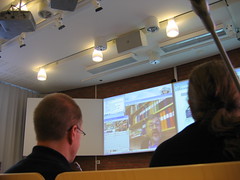For many businesses, particularly service oriented businesses, getting up in front of a group of prospects with the opportunity to demonstrate your knowledge and expertise is one of the best lead conversion opportunities going.
 Holding workshops and seminars live and in person has long been an effective tool. The web makes this tool even more powerful and more affordable as it allow you to conduct online versions of seminars that don’t require you to rent a room or your prospects to leave their homes and offices.
Holding workshops and seminars live and in person has long been an effective tool. The web makes this tool even more powerful and more affordable as it allow you to conduct online versions of seminars that don’t require you to rent a room or your prospects to leave their homes and offices.
Online seminars are a marketing tool every business should consider adding to the mix. Below are seven steps to consider to make your online seminars pay.
1) Get sponsored
Before you go too far down the seminar path consider getting sponsors to join you. This doesn’t have to be some big name corporate deal, give strategic partners the opportunity to join you in promoting your educational sessions for the right to call themselves a sponsor. Round-up prizes from related businesses that want the exposure their prize garners in your promotion. Free stuff drives enrollment!
2) Educate, don’t sell
Make certain that your “free” session is packed with content so good people would pay for it. That’s the expectation these days. If you create seminars that are basically veiled sales presentations, you won’t reap the benefits of this expertise play and people won’t come back or tell friends about your great seminars. There’s a time and place for the sales pitch, but only after you’ve established trust through sharing valuable information. People are OK with a “here’s the sales pitch” at the end of a presentation that was time well spent.
Consider creating a series of events and promoting them together. This can help build momentum and allow you to build a loyal following.
3) Pick your platform
There are dozens of online platforms for hosting your web seminars but choose your platform with some considerations in mind.
- Free may not be the best option if you are using this tactic to demonstrate how professional your business is.
- Look for a tool that offers some interaction tools such as polling, questions, chat, even video
- Make sure your chosen tool can handle the numbers you plan to enroll
- Be certain you can easily record your sessions for future marketing use
- Look for ease of use and follow-up reminder email automation
GoToWebinar (a sponsor of the Duct Tape Marketing podcast), Acrobat Connect and WebEx all offer the features above
4) Cause interaction
Use the functionality of your online webinar tool to get the audience involved. Polls are a great way to take the temperature of your audience and the results can make for both interesting discussion during your session and follow-up discussion in another form of content such as a blog post. With small groups you may want to allow video or audio chat, but it’s always a good idea to take questions from the attendees. Most platforms also allow you to conduct a survey at some point in your presentation. This is a nice way to end a presentation to get feedback from the audience and even let them vote on other topics they would like to hear in the future.
5) Create a backchannel
Lots of people attend webinars these days and share information they hear with their followers on Twitter. It’s become common practice to create a hashtag for your events so people who attend or those that don’t have an easy way to collect all of the comments made by listeners. Some presenters go as far as having an assistant monitor and tweet during the presentation to keep the conversation lively and accurate. This free PowerPoint Twitter Tool allows you to create tweets and have them posted automatically during your presentation.
6) Have bonus content
Because there is so much free information out there online the expectations for what you provide as free package have grown. In addition to the event itself consider creating a PDF workbook or collection of blog posts from yourself, related bloggers or strategic partners and delivering that document along with your follow-up. This gives you another reason to reach out and remind your attendees about the great content and gently about the products and services you offer.
7) Promote the archive
Use your chosen platform to record your presentation. Upload your recorded session to a video host such as Vimeo or YouTube and embed the video in a web page surrounded by additional resources and further reading links related to the topic. This is a great way to use the session for future marketing efforts and create the kind of page and content that search engines love. Consider using a service like CastingWords to transcribe the session, combine three or four session with video, transcript, resources and your collection of blog post PDF and you’ve just created a product that you can sell!
Handling all the moving parts of setting up, promoting, running and archiving live events can seem a bit overwhelming at first, but the long term payoff in terms of expertise, content, and trust building is worth every bit of it.
Image credit: hildgrim

